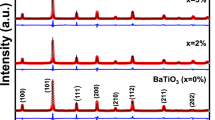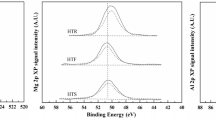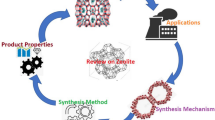Abstract
The bulk ionic conductivity of various sodalites (synthesized by the structure conversion method) and their starting materials, Linde molecular sieves, has been investigated over a temperature range between 300 to 700°K in a vacuum enclosure. The Arrhenius plots of these data indicate a single activation process. X-ray diffraction studies verify the conversion of molecular sieves into sodalite structures and also indicate that the unit cell parameter in sodalite is dependent upon the anion incorporated. The conductivity of sodalite is found to be dependent upon the unit cell parameter. Of the different materials studied, Cl-, Br-, I-sodalites and molecular sieves show progressively increasing conductivity and decreasing activation energy. The effect of adding sulfur to the sodalites is to raise the conductivity and lower the activation energy, relative to the undoped sodalites. These results are explained by a model based on the collapsing of the aluminosilicate framework into sodalite under the influence of the various halogens.
Similar content being viewed by others
References
A. H. Rosenthal, Proc. IRE,28, 203 (1940).
E. F. Williams, W. G. Hodgson, and J. S. Brinen, J. Am. Ceramic Soc.52, 139 (1969).
R. C. Duncan, B. W. Faughnan and W. Philips, Appl. Optics9, 2236 (1970).
W. Philips, J. Electrochem. Soc.117, 1557 (1970).
D. W. G. Ballentyne and K. L. Bye, J. Phys. D3, 1438 (1970).
D. J. Schipper, C. Z. Van Doom and P. T. Bolwijn, J. Am. Ceramic Soc.55, 256 (1972).
I. F. Chang, Electrochem. Soc. Meeting, Chicago, May 13–18, 1973, to be published in J. Electrochem. Soc.
I. F. Chang and A. Onton, AIME Mat. for Electronics Conf., Boston, August (1972). J. Mat. Electronics2, 17 (1973).
C. Z. Van Doom, D. J. Schipper and P. J. Bolwijn, J. Electrochem. Soc.119, 85 (1972).
P. T. Bolwijn, D. J. Schipper and C. Z. Van Doom, J. Appl. Phys.43, 132 (1972).
M. J. Taylor, D. J. Marshall, P. A. Forrester and S. D. McLaughlan, Rad. and Electronic Engineer.40, 17 (1970) or Forrester et al, NATO AGARD Proc. No. 5 (1970).
W. Philips and Z. J. Kiss, Proc. IEEE,56 2072 (1968).
I. F. Chang, unpublished. When a cathodochrome material is biased under a dc field the CC effect is enhanced. This has been observed in certain cathode — chromic material. The enhancement is presumably due to the migration of color absorbing centers in the material under an electric field bias.
I. F. Chang, unpublished. Experimental results indicate that nondestructive readout of information stored in a CC material may be possible by scanning the target with a reading beam (reduced current level) and detecting a secondary current caused by it.
O. Weigel, Z. Krist.58, 183 (1923).
G. Gross, Z. Krist.92, 284 (1935).
E. Rabinowitsch and W. C. Wood, J. Electrochem.39, 562 (19:
R. M. Barrer, J. Chem. Soc. London Part III, pp. 2342–2350 (1961).
I. R. Beattie, Trans. Faraday Soc.50), 581 (1954).
I. R. Beattie, Trans. Faraday Soc.51, 712, (1955).
I. R. Beattie and A. Byer, Trans. Faraday Soc.53, 61 (1957).
R. M. Barrer and E. A. Saxon-Napier, Trans. Faraday Soc.58, 156 (1962).
D. C. Freeman and D. N. Stamires, J. Chem. Phys.35, 799 (1961).
D. N. Stamires, J. Chem. Phys.,36, 3174 (1962).
R. A. Schoonheydt and J. B. Uytterhoeven, Molecular Sieve Zeolites I, Adv. Chem. Ser.101 (Editor R. F. Gould), 456 (1971).
F. J. Jansen and R. A. Schoonheydt, J. Chem. Soc. Faraday Trans. I,69, 1338 (1973).
R. Levy and A. Katchalsky, J. Colloid and Interface Sci.42, 366 (1973).
L. Pauling, Z. Krist74, 213 (1930).
R. M. Barrer, Proc. Chem. Soc. London, 99 (1953).
L. V. Azaroff, Elements of X-ray Crystallography, McGraw Hill Inc., N.Y. 484 (1968).
L. Broussard and D. P. Shoemaker, J. Am. Chem. Soc. 82, 1041 (1960).
D. W. Breck, W. G. Eversole, R. M. Milton, T. B. Reed and T. L. Thomas, J. Am. Chem. Soc.78, 5963 (1956).
T. B. Reed and P. W. Breck, J. Am. Chem. Soc.78, 5972 (1956).
ASTM Index of X-ray diffraction data - Powder Diffraction File Nos. 20-1070, 21-1097 and 21-1098. Also see T. Tomisaka and H. P. Eügster, Mineral. J. (Japan)5, 249 (1968).
F. M. Jaeger and F. A. Van Meile, Proc. Acad. Amsterdam30, 479 (1927).
D. Greene, New Scientist, May 11 1972.
D. C. Freeman, U.S. Pat. 3,106,875 (1965).
M. S. Whittingham and R. A. Huggins, J. Chem. Phys.54, 414 (1971).
J. Ciric, Science,155, 689 (1967).
J. F. Charnell, J. Crystal Growth,8, 291 (1971).
O. K. Mel’nikov and B. N. Litvin, Sov. Phys. Crystallo.10, 216 (1965).
K. L. Bye and E. A. D. White, J. Cryst. Growth6, 355 (1970).
Author information
Authors and Affiliations
Rights and permissions
About this article
Cite this article
Paul, D.K., Chang, I.F. Electrical properties of synthetic sodalites. J. Electron. Mater. 3, 709–729 (1974). https://doi.org/10.1007/BF02655294
Received:
Revised:
Issue Date:
DOI: https://doi.org/10.1007/BF02655294




